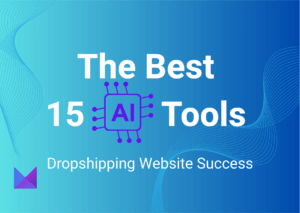Creating a dropshipping business continues to be a hot topic in e-commerce circles.
I’m sure you’ve already heard through the blogosphere the story of Justin Wong. He is an internet entrepreneur who made $12,000 within a month of launching his online store. He started his drop shipping business with zero investment and hit the proverbial jackpot in less than 30 days.
The remarkable thing is that Justin’s story is not unique. There are literally millions of other entrepreneurs who have started eCommerce stores without any upfront investment. In fact, at Modalyst, tens of thousands of new online stores come to market every month, each emboldened by the dream to build a legitimate and lucrative dropshipping business.
The question is how do you join this party? First, you need to understand what is involved in launching a dropship store and how it works.
What is Dropshipping?
Dropshipping is a retail method for online stores to sell products and have the suppliers ship the items directly to their customers.
This eliminates the challenges of holding inventory and allows you to focus on things like marketing and sales. The key difference between dropshipping and the standard retail model is that the selling merchant doesn’t warehouse or own any inventory.
Instead, the merchant purchases inventory as needed from a third-party — usually a brand, supplier, or wholesaler — to fulfill orders. So, the online seller never actually sees, holds or ships the item, they are effectively advertising it for the supplier and marketing up the price of the product so they can make a profit.
Not sure about your profit margin percentage? try out our Profit Margin Calculator
How does the Dropship Model Work?
In simpler terms, this is how dropshipping model works:
- The eCommerce merchant “stocks” products on their website or marketplace.
- The eCommerce merchant doesn’t actually hold these products. The products are warehoused by the supplier or wholesaler (who could be anywhere in the world). These products may cost $1 per unit from the supplier, while the eCommerce merchant lists them at $3 each (making a profit of $2 from the sale).
- When a customer orders a product from the eCommerce merchant’s website, the merchant receives a notification. The merchant then forwards that order to the supplier, either manually or automatically.
- The supplier fulfills the order and ships it directly to the customer under the drop shipper’s name.
Understand the Pros and Cons of the Dropshipping Business
Dropshipping offers the ability to start an eCommerce store without the inherent risks of owning inventory.
This is incredibly appealing to entrepreneurs who want to quickly launch a business without the hassle of overhead cost and shipping logistics. That being said, the drop shipping business comes with its own challenges that are often overlooked.
Every business model has its challenges and drop shipping is no different. In order to be successful, you should prepare yourself for some of the challenges you will likely be facing.
Customer Support
You are the one dealing with the customers. That means any issues that your suppliers have with shipping on time or delivery, in general, will fall on you. Make sure you are prepared for many hours of customer service. This is not necessarily a bad thing as any time you have direct communication with a user is an opportunity to retain or upsell.
Shipping
With shipping costs, you win some, you lose some.
Deciding on your shipping policy can be daunting since your suppliers will all be charging you different rates based on their location. While your inclination may be to focus on covering your costs, instead focus on your customer’s experience. If they are about to check out and find the shipping cost overwhelming, they will more than likely abandon the purchase.
Try offering flat rate shipping with a threshold for free (for example, after reaching $49, free shipping).
Check out: Shipping 101: Finding the Model to Match your Business
In general, approach shipping as “you win some, you lose some” mentality knowing that if you do your calculations properly, you are likely to even out at the end of the day suppliers may be a pain.
Remember you are relinquishing your control over inventory so you can only hope the suppliers have the same standard of customer service and professionalism that your store promises its customers.
This may not always be true so prepare yourself for constantly updating your product selection until you find the most consistent and reliable suppliers.
Modalyst, however, has implemented a vetting process for suppliers so the network is composed of reliable, high-quality brands.
Find the Best Shopping Cart Technology for You
Once you are committed to all the challenges (and excitements!) that come with drop shipping, it’s time to find a platform to start your e-Commerce store. There are a lot of options out there, so find the one that best meets your needs.
Do you have experience in designing and want something very customizable? Is this your first business and need something not too expensive?
First, decide on your priorities and use a version of the checklist below to evaluate the different options.
- Cost
- Website Hosting
- Website design
- Customization options
- Payment gateways offered
- Marketing tools
- Access to additional integrations/apps
- Analytics and Reporting
- Customer Service
Create an excel sheet or a simple list to help you compare and contrast the options.
Decide on your Intended Customers
If you haven’t already, now is the time to decide on your audience. As much as you would like to target users on a universal scale, the best place to start is with a niche user segment so you can focus your marketing efforts effectively. Once you know who you want to visit your store, you can apply better branding, messaging and find the best products for those particular customers.
Find Dropshipping Suppliers
Time to fill your store with products from the best dropshipping suppliers.
The times of Googling cool new wholesalers and brands are over thanks to the many dropshipping marketplaces out there that will provide lists of suppliers for you to choose from.
Depending on what you are looking to sell, there are dropshipping platforms offering mass-produced products at lower prices and some that are more curated with independents.
Modalyst, for example, offers fashion accessories, apparel, and home goods from a selected group of suppliers interested in building relationships with e-boutiques all over the world.
Our dropshipping app makes it easy for retailers to click to add products to their stores. Where it used to take an average of 38 days to develop a dropshipping relationship, with new technology like what Modalyst offers, it literally takes seconds.
Online stores can sign up for their free forever plan for full access to the dropshipping marketplace and experience the app that automates not only sourcing but also order fulfillment and inventory levels as well.
As a new eCommerce entrepreneur with several overlapping tasks to conduct, tools like the ones mentioned above can assist you to manage hundreds of suppliers and vendors in one centralized place.

Set up Social Media Accounts For Your Online Store
I should not need to convince you about the benefit of social media when developing a brand image for your dropshipping and eCommerce business.
You want your customers to understand your personality and feel like you are a friend they can trust, therefore making them more inclined to purchase from you.
Social media is a crucial asset for this not only as a way of communicating your brand’s message through graphic aesthetics but also as a channel for customer service.
Try not to be daunted by which channel to use.
Find the one that you are most comfortable with and give it a try. You can expand and branch out to multiple channels later on, but it is important to first experiment with the platform you believe is going to be most profitable for your specific clientele, hence the most worthwhile to spend a considerable amount of time on.
Instagram is known as a platform that has worked well for advancing various eCommerce stores due to its vast variety of visual templates and displays for business profiles, so you may want to start there. However, something crucial to note about Instagram as a platform is the matter of timing – If you can present a product to your potential customers through a dedicated Instagram post and follow up with a seamless user experience and product flow, you will likely capture that sale.
Make sure that you know the best time to post on Instagram as this will be the key to targeting the right audience for your product which will eventually lead to your followers and customers as well. Try to publish an Instagram post at a time in which you predict that most of your user segment is already scrolling and browsing on this social media platform.
Find Helpful Apps
In this day and age, you don’t have to hire a team of people to customize your store. There are third-party developers, as well as website builders and apps, that will help you for that!
Take advantage of all the eCommerce apps out there that you can use to create things like better user flow, email capture, rewards programs, etc.
All these things can greatly increase your chances of sales and are typically relatively easy to set up.
The Wix App Market in particular could be a highly beneficial place to explore for starters. The apps you want to focus on to start with are those that help you retain customers.
This can include things like pop-up boxes to learn more about the customer browsing your site so you can reach out with specific suggestions; discount offers after certain user behavior like adding an item to the cart and then abandoning; adding product reviews to encourage sales.
Create an eCommerce Marketing Strategy
Every online store must have a marketing strategy. And it cannot be that you will offer better pricing. Almost everything can be found on Amazon or eBay these days so that is a battle you will likely lose since they will always be able to offer lower prices. Instead, try reaching your customers before others do.
If you can present a product to them through a marketing email or Instagram post and follow up correctly, you will likely capture their attention and trust.
Focus on an audience that might not be looking for better pricing but more novelty, niche products, and personalized shopping experience. This is where you can win their trust, and complete the sale.
Lastly, be aware that retaining a customer is more cost-effective than finding new users. Once you capture a sale, spend time on nurturing that relationship because in the end, it is better for your bottom line.
Deploy Marketing Strategy
(Learn and Adjust)
The best lessons can be learned from the mistakes you make so don’t be afraid to try different tactics. There are so many things to choose from like Pinterest boards, Facebook ads, SEO, Snapchat etc.
Interestingly, studies show that email marketing is still the top way to drive traffic to your site. I would start there and slowly add on different channels.
The most important thing is to study the results so you don’t keep wasting time on something that isn’t working. For example, if you post a product on Instagram, make sure you have a link to the product in your bio so that people can easily click through to your site. You can then look at Google Analytics to see how much traffic originated from Instagram.
This is very valuable data for your business. If there are a lot of clicks and no sales, or if the bounce rate is too high, maybe this product is not right for your intended audience.
Make your First Sale
Once you can get people to your site, it’s time to focus on how to encourage sales to your online store. This is when website design, particularly the checkout experience, can greatly influence a purchase. Try studying other sites where you like to shop and take screenshots of each step in the check out process.
The key is to eliminate friction points so one doesn’t feel distracted or worse, frustrated when trying to buy something.
For first time buyers, this is an opportunity to capture their preferences.
For example, if the customer is buying a swimsuit, you may want to offer a discount on a beach towel in a few days since you can assume they are in the market for summer gear.
This doesn’t require anything high tech. Simply review your purchases every few weeks and look for ways to re-engage your customers in a personal way.
Retain Customers
As long as you provide a favorable experience for a customer’s first purchase, you should spend more time on ways to get them to come back to your site than finding new customers.
The reality is that returning customers are likely to spend more money than a new user, since you’ve retained customer satisfaction in their first purchase.
If you can build up a loyal customer base you can use them to help gain new users. For example, provide discounts to your customers that invite their friends to shop. Think of your best customers as your sales force. This could serve as an effective and efficient approach to finding new shoppers.
5 Best Ways to Retain your Customers Online
Analyze and Adjust
Running a business is a great and crucial learning opportunity. Consider the first few months a discovery phase when you are constantly trying new tactics, analyzing the results, and re-adjusting. While you might start with a specific vision for your store, always be prepared to pivot based on customer feedback. Early on illicit feedback from the users that successfully purchase but also those that abandon during checkout.
Don’t be afraid to ask why they left the site, you may be surprised to hear their answer.
Most importantly, embrace that learning how to start a dropshipping business is a tricky and competitive field. If you focus on measurable tactics, you’ll be able to hone in on what really works for your customer base and drive sales. If you would like to start a drop shipping business, sign up for Modalyst here or read more about eCommerce and starting a dropshipping store on our blog.





